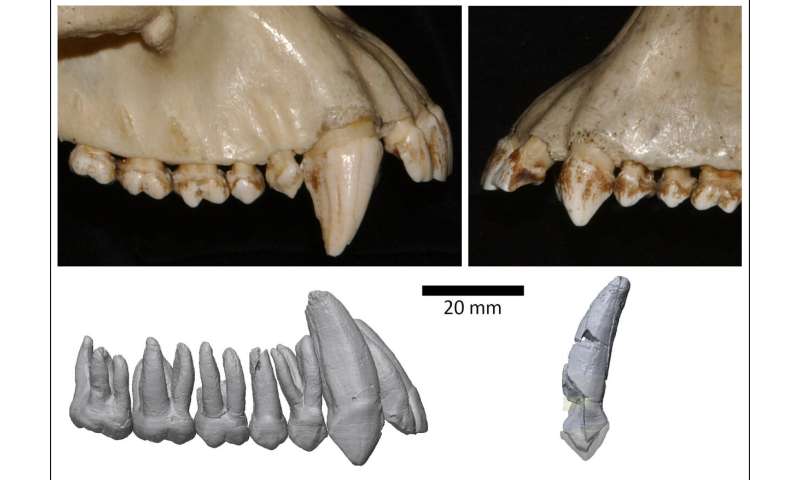Canine sexual dimorphism in Ardipithecus ramidus is estimated

A new method to estimate sexual dimorphism in fossil species near the base of our family tree has been just published in the Proceedings of the National Academy of Science (PNAS), through the joint efforts of the Middle Awash and Gona research groups, the latter led by Sileshi Semaw, archaeologist from the Centro Nacional de Investigación sobre la Evolución Humana (CENIEH) and Mike Rogers; and the former by Berhane Asfaw, Giday WoldeGabriel, Yonas Beyene, and Tim White, who is CENIEH affiliate.
Humans have the proportionately smallest male canines among all anthropoids and little canine sexual dimorphism. Ever since Darwin focused on this peculiarity of our species, scholars have wondered how and why it evolved. Until now, the evolutionary emergence of this defining character has remained unclear because of a lack of a reliable method for determining dimorphism in weakly dimorphic fossil species.
Sexual dimorphism is often quantified by a simple but fundamental ratio, the ratio between the average male versus female values of a particular feature such as the size of the canine tooth. Body size and canine size dimorphism have remained a focus of interest in paleoanthropology because of their implications for different ideas about past human societies and behaviors such as polygyny or monogamy.
When variation seen in fossils from an ancient fossil species is large, this can be caused by sexual dimorphism such as that seen in living baboons or gorillas. Previous methods of estimating dimorphism in fossils assumed that most such large variation stemmed from sexual dimorphism, but this approach is prone to error, particularly in weakly dimorphic species like humans and their ancestors.
Over a period of several years, Tomohiko Sasaki and Gen Suwa developed the new method that adequately takes into account the hidden distribution of both sexes within a fossil assemblage when estimating dimorphism. They used modern primate samples of known sex to verify that the new method actually worked. The strengths of this new method are that it can better estimate low, human-like levels of dimorphism, and that statistical probabilities can be calculated.
Once the method was developed and tested, it was published in the Proceedings of the National Academy of Sciences. Motivation from the study had originally come from the unique success of both teams in recovering fossils from ancient time horizons, their most celebrated discoveries being the ~4.5-million-year-old species Ardipithecus ramidus, including the most complete skeleton of the species, nicknamed "Ardi." The Gona and Middle Awash are so far the only study areas to have yielded substantial fossils belonging to this species.
Application of the new method required the teams to combine their fossil data from geologically contemporary time horizons in the two adjacent study areas. This combination allowed the assessment of canine size dimorphism in these early hominid fossils, as well as in later Australopithecus and Homo species that followed Ardipithecus in geological time. The results of applying the new method to a variety of early hominid fossils have now been published in PNAS.
By using the new method, we can now reliably say that canine sexual dimorphism levels were all probably very week in our fossil ancestors or relatives, such as the Ardi species at 4.5 million years ago, or the various other species of later Australopithecus and Homo. Our study demonstrates that canine sexual dimorphism in each of these species was indistinguishable from, or close to, the modern human condition, and weaker than in the bonobo (the least dimorphic and behaviorally least aggressive among living great apes).
The available fossil evidence therefore indicates a dramatic size reduction of the male canine tooth before the earliest known members of the human clade appeared, with little change in canine dimorphism levels thereafter. This suggests that a profound behavioral shift associated with comparatively weak levels of male aggression happened very early in human evolution, probably broadly coincident with the adoption of bipedality.
Among extant anthropoid primates, the relatively smallest male canines are known in species that are socially characterized by relatively tolerant male-male relationships and male-female codominance, such as in the bonobo or wooly spider monkey. Our analysis of the fossil evidence implies that this may have also been the case very close to the emergence of our earliest bipedal ancestors.
More information:
Tomohiko Sasaki et al, Estimating sexual size dimorphism in fossil species from posterior probability densities, Proceedings of the National Academy of Sciences (2021). DOI: 10.1073/pnas.2113943118
Canine sexual dimorphism in Ardipithecus ramidus was nearly human-like, Proceedings of the National Academy of Sciences (2021). DOI: 10.1073/pnas.2116630118.
Provided by CENIEH